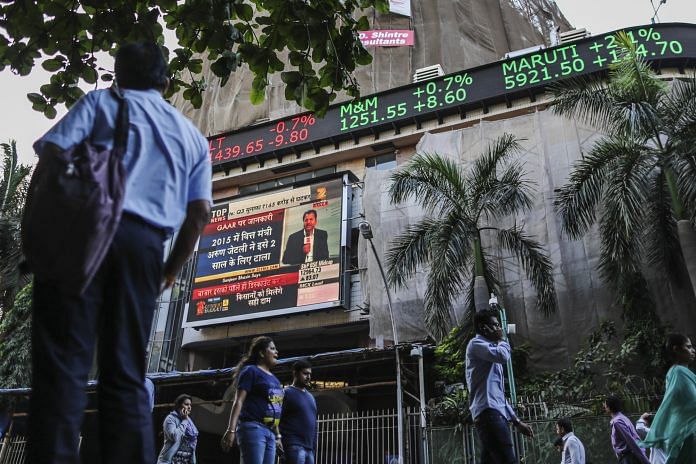New Delhi: India’s growth may have been overestimated by 2.5 percentage points every fiscal between 2011-12 and 2016-17, former chief economic advisor Arvind Subramanian has written in a new working paper, suggesting that economic slowdown may be a more pressing issue than it appears.
Titled India’s GDP Mis-estimation: Likelihood, Magnitudes, Mechanisms, and Implications, Subramanian’s working paper for the Center for International Development at Harvard University, US, is critical of Indian statisticians and the way India’s GDP growth has been estimated after 2011-12.
The period encompasses the tenure of both the UPA and the NDA governments.
Subramanian was chief economic advisor to the Modi government between October 2014 and June 2018.
Published this month, the paper finds that India may have grown at an average of only around 4.5 per cent in the period between 2011-12 and 2016-17 as against the official estimates that show India grew at an average of 6.9 per cent in the period.
The findings again bring to the fore the massive challenge faced by the Modi government to arrest India’s economic growth slide. Official estimates show that India grew at 6.8 per cent in 2018-19, as against 7.2 per cent in 2017-18 and 8.2 per cent in 2016-17.
‘Solid but not spectacular growth’
“The results in the paper suggest that the heady narrative of a guns-blazing India must cede to a more realistic one of an economy growing solidly but not spectacularly,” Subramanian writes.
He adds that growth must be restored as a key policy objective stemming from the new knowledge of weaker growth.
Further, Subramanian points out that the lower GDP growth could explain some of the “apparent puzzles of ongoing and intensifying corporate and financial system stress, weak new project announcements, and persistently low capacity utilization in manufacturing”.
He says the thinking was these “weaknesses were anomalies, existing despite good growth” but “in reality, all these weaknesses may have partly stemmed from weaker-than-believed growth”.
Also read: Interest rate cuts will make a difference only when they’re transmitted down the line
A measurement problem
The former chief economic advisor argues that India’s GDP growth faces a “measurement problem” after 2011.
Using a set of 17 “real indicators that are strongly correlated with GDP growth”, Subramanian writes that while 16 out of 17 indicators were positively correlated with GDP growth before 2011, 11 out of 17 indicators negatively correlated with GDP after that year.
The indicators he used include electricity consumption, sales of two-wheelers, commercial vehicles and tractors, airline passenger traffic, foreign tourist arrivals, railway freight traffic, index of industrial production, petroleum consumption, cement, steel, overall real credit, real credit to industry, exports and imports of goods and services.
As for the official GDP estimates being higher, Subramanian attributes it to higher estimation of formal manufacturing and over-estimation of informal sector activity using IIP data, when it was one of the worst-hit in the aftermath of demonetisation and the goods and services tax (GST).
‘GDP data cannot be left to statisticians alone’
Tearing into India’s statisticians who finalised the 2011 series GDP data between 2012 and 2014, Subramanian writes that important statistics cannot be left to statisticians alone.
“India must restore the reputational damage suffered to data generation in India across the board — from GDP to employment to government accounts — not just by conferring statutory independence on the National Statistical Commission, but also appointing people with stellar technical and personal reputations,” writes the former chief economic advisor.
Subramanian refers to the criticism of the GDP back-series data released by the Modi government which drastically scaled down growth numbers under the UPA years.
Also read: A $13 billion fund still has faith in Indian consumer stocks, sees slowdown temporary
“At the same time, the entire methodology and implementation for GDP estimation must be revisited by an independent task force, comprising both national and international experts, with impeccable technical credentials and demonstrable stature. And it must include not just statisticians but also macro-economists and policy practitioners,” he says.
“If statistics are sacred enough to require insulation from political pressures, they are perhaps also too important to be left to the statisticians alone.”







My point is why was Mr Arvind quiet all years he was working with the govt. He could have saved the economy the doldrums it presently is in… Had he opened up earlier. Why do all these intellectual geniuses like Raghuram Rajan and Arvind (CEA) wake wearing a superhero CAPE once they are out of system or should I say done with enjoying certain privileges of being a BABU in this nation.
Growth figures do not matter, especially when there is so much international linkage these days. Governance does. So stick to good governance, growth will follow.
Khichdi pak rahi thi kitchen mein, aur master chefs ko mehek nahin aayee … I don’t think there was any problem of methodology. A conscious decision was taken to make the growth figures look more appetising, like the dossiers that were created to justify the invasion of Iraq. It took a while for the world to figure out what was going on, because there was the inertia of trust created over decades. Now everyone is using high frequency indicators to assess the health of the economy. Winning the trust of serious investors will not be easy. A run of the mill Budget, with some verses from Tamil poets, will not be good enough.
What was this fellow doing in his 4 years in govt as Chief Economic Adviser?
Head buried in sand so that only his thinking parts were visible — as they are now!